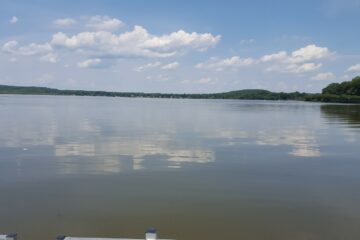The South Branch of the Raritan River is set to become a healthier habitat for migratory fish and wildlife with the planned removal of the Rockafellows Mill Dam, located in Readington and Raritan Townships, Hunterdon County. Like many dams in the U.S., this structure no longer serves its original purpose. Instead, it now poses safety risks, degrades water quality, blocks fish migration, and increases the risk of local flooding.
Raritan Headwaters has been awarded a $2.3 million grant from the National Oceanic and Atmospheric Administration (NOAA) to support the dam’s removal. The project is expected to take three to four years to design and complete.
This grant, the largest project-based award in RHA’s history, highlights the importance of the project and the collaborative efforts behind it. The funding comes from NOAA’s “Restoring Fish Passage through Barrier Removal” program.
Additional matching funds for the project will be provided by the Natural Resource Damage Assessment and Restoration (NRDAR) program. These funds, overseen by the New Jersey Department of Environmental Protection, NOAA, and the U.S. Fish and Wildlife Service, are part of a settlement to compensate for pollution damage at the Cornell-Dubilier Electronics Superfund site in South Plainfield. The NRDAR funds will also support the removal of two other obsolete dams along the South Branch.
This is a historic moment, not just for RHA but for the entire region. Removing these dams will greatly improve fish migration, reconnect our rivers, and enhance the health of our ecosystems. We are proud to be part of a national effort to restore migratory pathways and strengthen community resilience against climate change.
The Rockafellows Mill Dam, the downstream-most barrier to fish passage on the South Branch, creates a 13-acre impoundment that leads to sediment buildup, reduced wildlife habitat, and poor water quality.
The dam’s removal is one of 46 fish passage projects recently selected by NOAA across the U.S. for federal funding, thanks to the Bipartisan Infrastructure Law and the Inflation Reduction Act. Nearly $240 million has been allocated to restoring access to healthy habitats through fish passage projects. The Rockafellows Mill project is one of only two in New Jersey to receive substantial federal support and marks the first time such funds have been allocated for a project in the Upper Raritan River watershed.
The river restoration initiative will be further strengthened by preserving open spaces around the dam sites. In 2023, 16 acres along the South Branch in Readington and Raritan Townships were preserved through efforts led by Raritan Headwaters, New Jersey Conservation Foundation, Hunterdon Land Trust, and the Readington Open Space Advisory Board. Critical support came from the New Jersey Green Acres Program, the Hunterdon County Open Space, Farmland and Historic Preservation Trust Fund, and Raritan Township Municipal Open Space Funds.
Four parcels of land, totaling 16 acres—12 acres in Readington and 4 in Raritan—were preserved to protect the natural landscape for wildlife and watershed protection. These preserved lands support species such as bald eagles, ospreys, waterfowl, wading birds, and a variety of fish, contributing to the ongoing restoration of the South Branch ecosystem.
Since 2018, Readington Township has prioritized preserving land along the South Branch of the Raritan River, aligning with both Hunterdon County and local open space goals. The municipality has preserved over 75 acres along the river and are now moving forward with stream restoration to create a cleaner, cooler, and healthier environment for trout, shad, and other migratory fish.
Restoring Fish Passage Nationwide
NOAA is supporting the Raritan Headwaters Association’s critical work to improve fish passage and support migratory fish on the Raritan River. They will provide technical assistance and funding through competitive grants over the next five years to remove dams and other barriers, restoring migratory pathways and access to healthy habitats for fish across the U.S.
These projects not only support the recovery of endangered migratory fish and improve fisheries but also provide community and economic benefits, such as enhanced recreational opportunities and increased climate resilience. Removing outdated infrastructure will help communities adapt to climate change by reducing flood risks and other climate-related challenges.
NOAA’s selection process was highly competitive, with four times more applicants than available funding. We are honored to have been selected and excited to contribute to the restoration of fish habitats and the revitalization of our rivers.
To learn more about improving fish passage, visit NOAA’s website. For more information on how Natural Resource Damage funds are improving the Raritan River’s ecology, click here.



